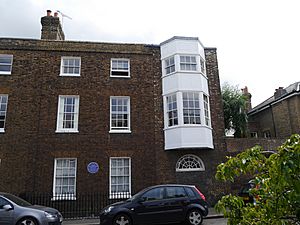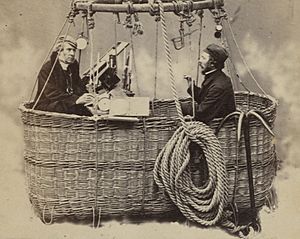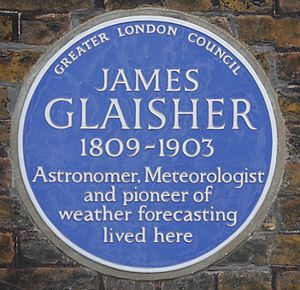James Glaisher facts for kids
Quick facts for kids
James Glaisher
|
|
|---|---|
 |
|
| Born | 7 April 1809 Rotherhithe, London, England
|
| Died | 7 February 1903 (aged 93) Croydon, Surrey, England
|
| Spouse(s) | |
| Children | 3 (incl. James) |
| Scientific career | |
| Fields | Meteorology |
James Glaisher (7 April 1809 – 7 February 1903) was a famous English scientist. He studied the weather, flew in hot air balloons, and looked at stars. He was also a Fellow of the Royal Society, which is a big honor for scientists.
Contents
About James Glaisher
James Glaisher was born in Rotherhithe, London. His father was a watchmaker. James started his science career at the Cambridge Observatory from 1833 to 1835.
After that, he moved to the Royal Observatory, Greenwich. He worked there for 34 years. He was in charge of the department that studied weather and magnetism.
In 1845, Glaisher created special tables. These tables helped people measure the amount of moisture in the air, which is called humidity. In 1849, he became a member of the important Royal Society.
Starting New Science Groups
Glaisher helped start several important science groups. He was a founding member of the Meteorological Society in 1850. This group studies weather. He was also a founding member of the Aeronautical Society of Great Britain in 1866. This group studies flying.
He was the president of the Royal Meteorological Society from 1867 to 1868. Glaisher also joined The Photographic Society in 1854. This group later became the Royal Photographic Society. He was their president for many years. He was also the president of the Royal Microscopical Society.
Amazing Balloon Flights
James Glaisher is most famous for being a pioneer in hot air ballooning. Between 1862 and 1866, he made many flights. He usually flew with Henry Tracey Coxwell as his co-pilot.
Their goal was to measure the temperature and humidity high up in the atmosphere. They wanted to reach the highest possible altitudes.
Breaking Altitude Records
On 5 September 1862, Glaisher and Coxwell made a record-breaking flight. They went higher than anyone before them. Glaisher passed out when they reached about 8,800 meters (29,000 feet). He could not take any more readings. One of the pigeons they brought with them also died.
Experts believe they went even higher, possibly over 9,500 meters (31,000 feet). Some even think they reached as much as 10,900 meters (35,700 feet) above sea level.
During this flight, Glaisher lost consciousness. Coxwell also lost feeling in his hands. The rope to release the balloon's valve got tangled. With great effort, Coxwell climbed onto the balloon's ropes. He managed to open the vent before he also passed out. This allowed the balloon to come down to a safer height.
Glaisher lived at 20 Dartmouth Hill in Blackheath, London. There is a special blue plaque there to remember him.
Glaisher and Coxwell made more flights after this. The Smithsonian Institution says that Glaisher "brought along delicate instruments to measure the temperature, barometric pressure and chemical composition of the air. He even recorded his own pulse at various altitudes." This shows how careful he was with his scientific work.
In 1871, Glaisher published a book about his balloon flights. It was called Travels in the Air. It was a collection of reports from his experiments. He included drawings, maps, and exciting stories. This helped many people learn from his adventures and observations.
James Glaisher died in Croydon, Surrey, in 1903. He was 93 years old.
Family Life
In 1843, James Glaisher married Cecilia Louisa Belville. Cecilia's father also worked at the Royal Observatory, Greenwich.
James and Cecilia had three children. Their two sons were Ernest Glaisher and the famous mathematician James Whitbread Lee Glaisher (1848–1928). They also had one daughter, Cecilia Appelina (1845–1932).
How He Is Remembered
A crater on the Moon is named after James Glaisher. The name was approved by the IAU in 1935.
See also
 In Spanish: James Glaisher para niños
In Spanish: James Glaisher para niños




